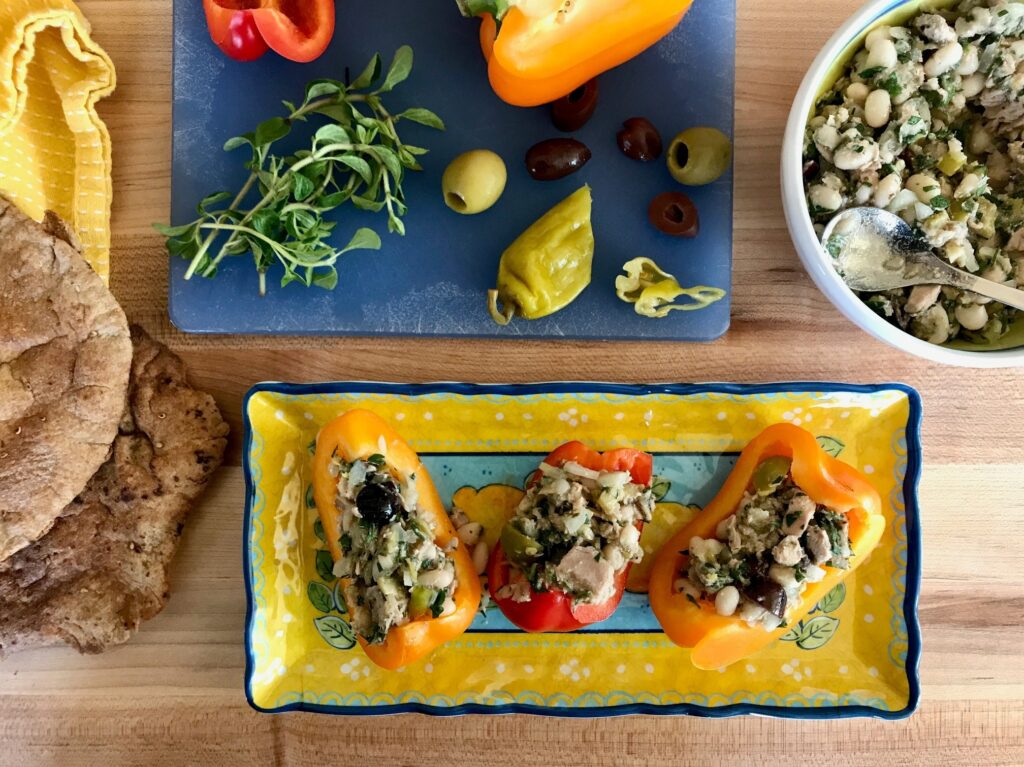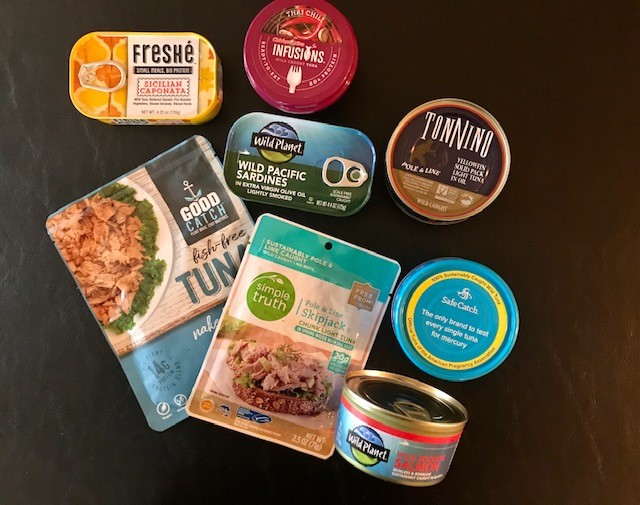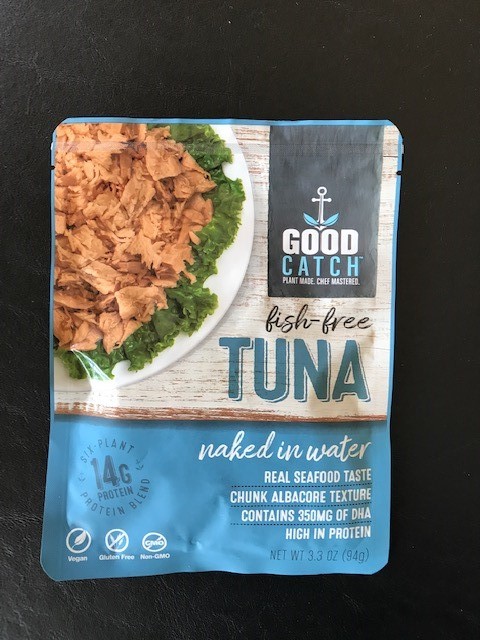Greek-Style Tuna and White Bean Salad

February is American Heart Month. Did you know the American Heart Association (AHA) recommends that healthy people eat one to two meals each week of fish or shellfish, especially the oily kind rich in omega-3 fats, eicosapentanoic acid (EPA) and dososahexanoic acid (DHA)?
The benefits are big. Regular seafood consumption can help to reduce your risk of heart disease, stroke, sudden cardiac death, heart failure, coronary heart disease, and congestive heart failure (1,2).
Omega-3 fats may reduce the risk or arrhythmia that can lead to cardiac death, decrease triglyceride levels in the blood and slow the buildup of fatty deposits that can clog arteries. Omega-3 fats are incorporated into cell membranes, so they help keep the heart and other organs functioning optimally (8).
Check the list “Omega-3 Content of Frequently Consumed Seafood Products, “(6) and choose a variety. Beyond omega-3 fats, seafood offers top-quality protein and nutrients such as B12, iron, zinc, choline, vitamin D, iodine and selenium.
What helps the heart often helps the brain: Seafood consumption, especially types rich in omega-3 fats, is associated with healthy aging and reduced risk of age-related cognitive decline. (3,4). Seafood consumption also helps the young, including the developing fetus.
The recommendation for women who are pregnant, could become pregnant or are breast feeding is 2 to 3 low-mercury seafood meals each week because the omega-3 fatty acids and other nutrients in fish and shellfish nourish the developing nervous system, brain and eyes of the fetus and young child, as well as support the mom’s health.
Find low-mercury choices in “Advice about Eating Fish for Women Who Are or Might Become Pregnant, Breastfeeding Mothers, and Young Children” (7) from the U.S. Food and Drug Administration (FDA) and the U.S. Environmental Protection Agency (EPA). It divides seafood into three categories “Best Choices,” “Good Choices” and “Choices to Avoid” based on mercury content.
The AHA acknowledges the importance of choosing low-mercury seafood for women who are or may become pregnant and children. Too much mercury can harm brain development in the fetus and young child and hamper cognition in children. For others, the AHA says that the benefits of eating one to two fish meals a week outweigh any possible health risk of mercury (2,9).
The AHA advice lines up with that of the Dietary Guidelines for Americans, (DGA) 2020-2025 to enjoy two seafood meals each week, about eight ounces total for adults and smaller portions for children (5) – similar to the AHA which says a “meal” is 3 ½ ounces or ¾ cup non-fried fish or shellfish.
Despite the benefits of eating seafood, almost 90% of Americans don’t meet consumption recommendations. The average adult intake is under 3 ounces a week (5,3). Shelf-stable choices can help narrow the gap. They are convenient, require no cooking and can be economical.

If you don’t like cans, grab a pouch or tub of shelf-stable seafood. Some are already flavored (think lemon-pepper or spicy Thai) so you just dig in with a fork or spoon onto crackers, toast or greens. If you’re shopping for omega-3 fats, you find lots of choices – shelf-stable wild salmon, tuna, sardines, herring, mackerel and trout.
Look for “no added salt” if sodium is a concern. Oil-packed varieties taste silkier eaten straight from the container, but you can always add your own. Salmon and sardines can be a good source of calcium if you buy versions with bones, made edible by the canning process. Or look for versions without skin or bones.
Sustainability or mercury concerns holding you back? A can of Wild Plant skipjack tuna indicates that it was sustainably pole and line caught, with no nets in a turtle- and dolphin safe way. It is 100% tuna (no added salt, oil, water or broth) and “skipjack is one of the tuna species lowers in mercury.” All omega-3 fats are retained in the can and the average is 374 mg DHA and EPA per can.

The SafeCatch brand of Elite Wild Tuna (also skipjack) says it is “the only brand to test every single tuna for mercury,” and “official tuna of the American Pregnancy Association.” It is “8x lower in mercury than albacore tuna” and “mercury average is 22x below FDA limit.” It too is 100% sustainably caught, dolphin- and turtle-safe. A 5 ounce can has a whopping 40 grams of protein.
Kroger addresses these issues, too. The label on a 5-ounce can of “simple truth” skipjack tuna says it was sustainably pole & line caught and it bears the blue MSC symbol showing it was certified by the Marine Stewardship Council. The can offers 27 grams of protein, less than SafeCatch because part of the contents is water (and sea salt) but it still offers fabulous nutrition.
These are just a few examples. You’ll even find something for those who can’t or choose not to eat seafood- “fish-free” alternatives made with plant proteins and algae to supply omega-fats.

Make eating seafood easy – try Greek-Style Tuna and White Bean Salad with green and black olives, pepperoncini and oregano. Your heart will thank you.
Note: Eating seafood isn’t the only way to be proactive about cardiovascular health. Check out “8 Things You Can Do to Prevent Heart Disease and Stroke” (9).
Greek-Style Tuna and White Bean Salad
Instead of tuna, try salmon, mackerel or even sardines. Serve as an appetizer, snack or light meal. If your seafood is packed in water or broth, drain it.
Serves 2-3
3 Tbsp fresh lemon juice
2 Tbsp chopped fresh oregano, dill or thyme (or 2 tsp dried)
1 cup cannellini or other white beans
1 can (about 5 ounce) tuna
1/2 cup chopped red onion or sweet onion such as Walla Walla
1/3 cup coarsely chopped pitted black and/ or green olives
1/3 cup chopped parsley, green onion or a combination
2 -3 tablespoons chopped, drained pepperoncini, optional
3 tablespoons olive oil
Salt and pepper, to taste
- In bottom of a bowl combine lemon juice, oregano, white beans, tuna (undrained unless packed in water or broth), onion, olives, parsley and/or green onion and pepperoncini. Blend well. Stir in olive oil. Add salt and pepper to taste. Cover and chill for one hour or longer for flavors to blend.
- Serve on pita, crackers, or toasted flatbread. Or spoon into bell pepper wedges or half of an avocado.
References
- Seafood Long-Chain n-3 Polyunsaturated Fatty Acids and Cardiovascular Disease: A Science Advisory from the American Heart Association. Eric B. Rimm, Lawrence J. Appel, Stephanie E. Chiuve, Luc Djoussé, Mary B. Engler, Penny M. Kris-Etherton, Dariush Mozaffarian, David S. Siscovick, Alice H. Lichtenstein, … Circulation. May 17, 2018.
- Keep saying yes to fish twice a week for heart health. American Heart Association Scientific Advisory May 17, 2018
- Meeting Weekly Seafood Recommendations. Jill Weisenberger, MS, RDN, CDCES, CHWC, FAND. Today’s Dietitian. October 2020. Vol. 22, No. 8, P. 34.
- Your Guide to Healthy Seafood Choices. Consumer Reports On Health. December 2019
- Dietary Guidelines for Americans 2020-2025
- Omega-3 Content of Frequently Consumed Seafood Products. Seafoodhealthfacts.org
- Advice about Eating Fish for Women Who Are or Might Become Pregnant, Breastfeeding Mothers, and Young Children
- Eating fish twice a week reduces heart stroke risk. American Heart Association News. May 17, 2018.
- 8 Things You Can Do to Prevent Heart Disease and Stroke
© Lorelle Del Matto 2021
 About lorelle
About lorelle
Hi Lorelle,
I very much enjoyed and appreciate this issue and am going to order some of these Tuna’s to try soon. Also, looking forward to trying your recipe for “Greek Style Tuna and White Bean Salad”.
Otherwise, I hope that you and your family are all doing and staying well on all fronts.
With very best regards and appreciation,
Leonard
Hi Leonard! Thank you for your comment! It means so much to me! Sorry for the delay – took a month off, traveling to Tucson to get a sun break from Seattle. All is well and I hope for you, too!
Lorelle